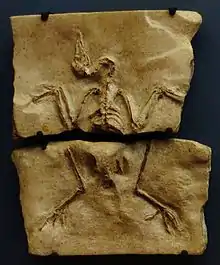Ludiortyx
Ludiortyx is a bird genus from the Late Eocene. Its remains have been found in the Montmartre Formation at the Montmartre (Paris, France). A single species is accepted, Ludiortyx hoffmanni.
| Ludiortyx Temporal range: Late Eocene | |
|---|---|
 | |
| Skeleton | |
| Scientific classification | |
| Missing taxonomy template (fix): | Neoaves/? |
| Order: | Gruiformes (?) |
| Genus: | Ludiortyx Brodkorb, 1964 |
| Species: | L. hoffmanni |
| Binomial name | |
| Ludiortyx hoffmanni (Gervais, 1852) | |
| Synonyms | |
|
Genus:
Species:
and see text | |
This bird is of uncertain relationships; it has been variously considered to be an ancestral rail or to belong to the Quercymegapodiidae, a prehistoric group of Galliformes (landfowl). The material assigned to it were initially considered to be of 2 species, one that was at first believed to be a Tringa wader, the other assigned to the galliform genus Palaeortyx.[1] Even the latter assignment was probably much in error as though its relationships are not known, Palaeortyx was probably not a quercymegapodiid.
Synonyms
Apart from the genus-level synonym Eortyx, L. hoffmanni has undergone quite a number of name changes due to the confusion about its placement: [1]
- Tringa hoffmanni Gervais, 1852
- Palaeortyx hoffmanni (Gervais, 1852)
- Palaeortyx blanchardi Milne-Edwards, 1869
- Ludiortyx blanchardi (Milne-Edwards, 1869)
- Eortyx hoffmanni (Gervais, 1852)
Footnotes
- Mlíkovský (2002)
References
- Mlíkovský, Jirí (2002): Cenozoic Birds of the World, Part 1: Europe. Ninox Press, Prague. ISBN 80-901105-3-8 PDF fulltext